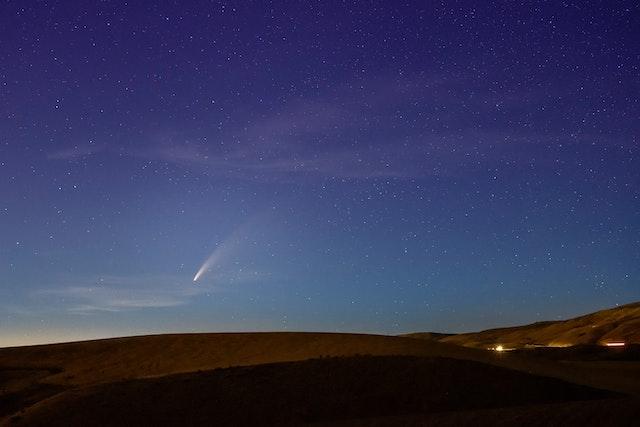
Meteorites are natural space debris that does not completely dissolve during their passage through the atmosphere.
Every night, you can witness a brilliant flash streak across the sky. Meteors are lovely, breathtaking, and a reminder that space junk lies strewn throughout the solar system; some of its rain is down on Earth.
Meteorites (particles from space that have survived to strike the surface of Earth) are highly prized by collectors because they preserve a piece of the distant sun in their grasp.
Where do meteorites come from?
Actually, most meteorites come from just two sources: the Moon and Mars.
The Apollo missions to the moon returned over 380 kilograms of rocks, pebbles, and dust. Most of these samples were scooped up from the lunar surface by the astronauts during their extra-vehicular activities (EVA).
The Soviet Union’s Luna robotic probes also returned some lunar material, and a few meteorites have been discovered on Earth that is thought to be of lunar origin (these rocks have chemical compositions that match those of Apollo samples).
Most Martian meteorites, on the other hand, come from a single source: a large impact crater called Gale Crater.
This crater is located on the equator of Mars and is about 154 kilometers in diameter. It was formed by a large meteorite impact about 3.8 billion years ago.
The Gale Crater meteorite is thought to have been a very large iron-nickel meteorite, similar to the one that formed the famous Meteor Crater in Arizona, USA.
A small number of other Martian meteorites have also been found on Earth, but their origins are not yet known.
Read also: What would happen to your body if you were in the vacuum of space
How are meteorites formed?
The vast majority of meteorites are formed when asteroids break up in space. These asteroids are often located in the asteroid belt, a region of the solar system between the orbits of Mars and Jupiter.
When an asteroid breaks up, it forms a cloud of debris that can eventually coalesce into new asteroids. However, some of this debris will end up on a collision course with Earth.
When this happens, the debris enters Earth’s atmosphere at high speeds and burns up, creating a meteor shower. If any of the debris survives the journey through the atmosphere and hits the ground, it is known as a meteorite.
Meteorites can also be formed when comets break up in space. Comets are small, icy bodies that orbit the sun. They are often located in the outer solar system, beyond the orbit of Neptune.
When a comet breaks up, it forms a cloud of debris known as a meteoroid stream. This stream can eventually cross Earth’s orbit and cause a meteor shower.
However, most of the debris from a comet will burn up in Earth’s atmosphere and only a small amount will hit the ground.
Read also: What Would Happen If People Attempted To Set Foot On Jupiter
What are meteorites made of?

Meteorites are pieces of rock that fall to Earth from space. They can be made up of a variety of materials, depending on their origin.
Lunar meteorites, for example, are primarily made up of anorthosite and breccia, while Martian meteorites are primarily made up of basalt and shergottite.
In general, meteorites are classified based on their composition, with the three most common groups being iron, stony, and stony-iron meteorites.
Iron meteorites, which make up about 7% of all recovered meteorites, are the most valuable kind because they are the most difficult to produce artificially.
Stony meteorites, which make up about 93% of all recovered meteorites, are relatively easy to produce artificially and as a result, are not as valuable.
Stony-iron meteorites, which make up the remaining 1% of recovered meteorites, are intermediate in terms of both composition and value.
Read also: What Is The Difference Between Dark Matter And Dark Energy
Where are meteorites most likely to be found?
Meteorites are most likely to be found in desert regions, such as the Sahara Desert in Africa or the Atacama Desert in Chile.
This is because these regions have large areas of open space with very little vegetation, making it easier to spot meteorites that have fallen to the ground.
Meteorites are also sometimes found in glaciers, such as the Antarctic ice sheet.
This is because glaciers can act as a ‘conveyor belt,’ transporting meteorites that fall on their surface to lower altitudes where they are more likely to be found.
How are meteorites identified?
There are a number of ways to identify a meteorite.
Look for a physical description
The first step is to look for a physical description that matches one of the known types of meteorites.
For example, iron meteorites are often rusty in appearance and have a high density, while stony meteorites are typically grey or black in color and have a lower density.
Look for evidence of a meteoritic origin
The second step is to look for evidence of a meteoritic origin. This can be done by searching for fusion crust, which is a thin, glassy coating that forms on the surface of a meteorite when it burns up in Earth’s atmosphere.
It can also be done by searching for regmaglypts, which are thumbprint-like indentations that form on the surface of a meteorite as it abrades in the atmosphere.
Perform a chemical analysis
The third step is to perform a chemical analysis of the meteorite. This can be done using a variety of methods, such as X-ray fluorescence, inductively coupled plasma mass spectrometry and atomic absorption spectroscopy.
Meteorites can also be identified by their magnetic properties. Iron meteorites are attracted to magnets, while stony meteorites are not.
Read also: What Happens If The Moon Crashes Into Earth
Final thought
Meteorites are pieces of rock that fall to Earth from space. They vary in size, from small pebbles to large boulders, and can be composed of a variety of different materials.
Meteorites typically fall to Earth at high speeds and can cause significant damage if they hit people or structures. In some cases, they can even be deadly.
Despite the potential dangers they pose, meteorites have long been a source of fascination for scientists and the general public alike.
They provide us with a glimpse into the vastness of space and the many different types of objects that exist out there.
Each meteorite is unique, and studying them can give us valuable insights into the formation and history of our Solar System.



